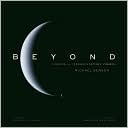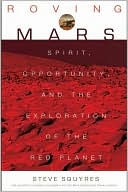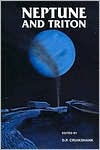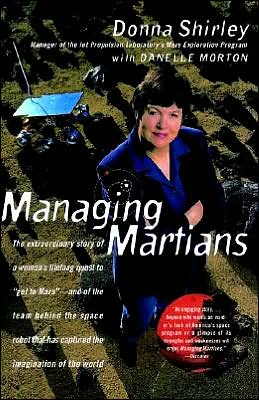Trailblazing Mars: NASA's Next Giant Leap
"Trailblazing Mars explains what people did and do to understand our planetary neighbor. But much more than that, Dr. Duggins tells you what our explorers were thinking. He gives you the how of the process along with the facts. Who knows what trails this book will help blaze? Read on."-Bill Nye the Science Guy, Executive director of the Planetary Society" "No planet of the solar system has been more inviting for humanity than Mars, a reddish point of light through a telescope but a beckoning...
Search in google:
"Trailblazing Mars explains what people did and do to understand our planetary neighbor. But much more than that, Dr. Duggins tells you what our explorers were thinking. He gives you the how of the process along with the facts. Who knows what trails this book will help blaze? Read on."-Bill Nye the Science Guy, Executive director of the Planetary Society" "No planet of the solar system has been more inviting for humanity than Mars, a reddish point of light through a telescope but a beckoning mystery once it was opened for exploration in the space age. In Trailblazing Mars, Pat Duggins presents an accessible history of the 'little robots who could' that were sent to the red planet and transmitted back to Earth knowledge about Mars and its watery past that may have spawned life. From the Mariner probes of the 1960's to the rovers Spirit and Opportunity, from fanciful human travel in science fiction to realities for human exploration in the future, this book places into context the lure of the red planet and our desire to know it better."-Roger Launius, senior curator, National Air and Space Museum, Smithsonian Institution" "When the flights to the Moon ended in 1972, so did a lot of the personal attention given to the John Glenns, Neil Armstrongs, and Buzz Aldrins of space. Pat Duggins restores that focus in Trailblazing Mars, presenting highly personalized stories about the men and women who build spacecraft, design instruments, manage missions, and fly into space. Mars may be the destination, but the book is really a study of the people who have taken us as far as we have come, including the ones who build spacecraft on which humans do not fly. Duggins has written a marvelous book, sure to inspire our imaginations and remind us that all space travel ultimately arises from human ingenuity."-Howard McCurdy, author of Space and the American Imagination" "Duggins is a veteran of space exploration coverage, and a fount of information when it comes to all things NASA. Trailblazing Mars takes a comprehensive look at what could be the future for Americans-and indeed humanity-in space as NASA and the United States reshape human space exploration plans. The only question left is 'When will the rest of us get to go?"-Tariq Malik, Space.com" "Travel to and from the red planet has long been a staple of science fiction. And yet the hurdles-both technological and financial-have kept human exploration of Mars from becoming a reality. Trailblazing Mars offers an inside look at the current efforts to fulfill this dream." "Award-winning journalist Pat Duggins begins with a look at Mariner 4, the first probe to reach Mars, built at the same time the Mercury astronauts were exploring near-Earth orbit. He reminds us of the excitement generated by the Viking and Pathfinder expeditions-and the disappointments of Biosphere 2 and the loss of more recent unmanned missions that crashed into the red-orange dust of Mars." "The bulk of the book is dedicated to examining the extreme new challenges that will be faced by astronauts on the journey to Mars and back. They'll have to grow their own food, find their own water, and solver their own problems and emergencies without hope of rescue or re-supply. Mars travel will be more challenging and hazardous then settling the Old West-but we were not witness to the fate of the Donner Party on CNN." Can the technological hurdles be cleared? Will the public accept the very real possibility of astronaut death? Should a mission be publicly or privately funded? Is the science worth the cost? These and many other questions are answered in Duggins's exciting new book. Publishers Weekly Right from the start Duggins (Final Countdown) engages readers with the social context of space exploration. While the existing knowledge of Mars and the challenges of sending a human being to the red planet are the focus of the book, Duggins also provides an enjoyable, illustrated history of the space program, informing us that "The debate over the human risk and the breathtaking cost of sending astronauts to Mars... goes back even farther than the first launch of Shuttle Columbia in 1981." Readers will relive the program's tragedies, triumphs, and frustrations as Duggins details the particular challenges of life on Mars, drawing comparisons to pioneers of America's westward expansion and the scientists who spent two years in the Biosphere. From engineering fresh water to growing food in a contained, limited environment, a human trip to Mars is a complicated undertaking made more challenging by the length of the journey. With Mars exploration proposed for the 2030s, Duggins's timely and engrossing study will interest explorers and armchair astronauts alike, and remind readers of the excitement of outer space. Photos. (Sept.)
Prologue 11 Mariner Sets Sail 62 The Space Race to Mars 213 Reheating the Leftovers of Apollo 254 Viking, NASA's "Gold Bug" 415 The Twenty-Year Gap 596 The Shuttle's Long Good-bye 817 Pioneers Past and Present 1068 The Moon, One Baby Step 1169 The New "Right Stuff" 13510 Lessons from Biosphere 2 15211 Plowing the "Back 40" on Mars 15912 Should NASA Go It Alone? 17113 Getting There, Living There 18714 Why Go at All? 201Epilogue 211Acknowledgments 217Notes 219Suggested Reading 233Index 235
\ Publishers WeeklyRight from the start Duggins (Final Countdown) engages readers with the social context of space exploration. While the existing knowledge of Mars and the challenges of sending a human being to the red planet are the focus of the book, Duggins also provides an enjoyable, illustrated history of the space program, informing us that "The debate over the human risk and the breathtaking cost of sending astronauts to Mars... goes back even farther than the first launch of Shuttle Columbia in 1981." Readers will relive the program's tragedies, triumphs, and frustrations as Duggins details the particular challenges of life on Mars, drawing comparisons to pioneers of America's westward expansion and the scientists who spent two years in the Biosphere. From engineering fresh water to growing food in a contained, limited environment, a human trip to Mars is a complicated undertaking made more challenging by the length of the journey. With Mars exploration proposed for the 2030s, Duggins's timely and engrossing study will interest explorers and armchair astronauts alike, and remind readers of the excitement of outer space. Photos. (Sept.)\ \







